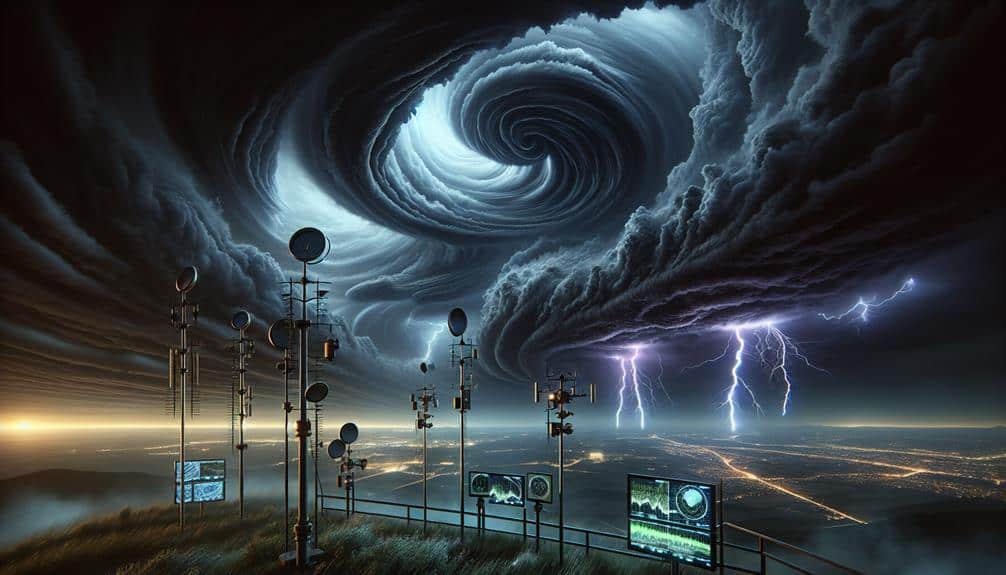Accurate storm forecasting is crucial for us storm chasers to ensure safety and optimize data collection. Advanced radar technologies, like Doppler radar, offer high-resolution data, while satellite insights provide real-time atmospheric conditions. Machine learning algorithms enhance our predictive power by identifying severe weather patterns and changes. This precise forecasting allows us to anticipate storm paths and intensities, executing effective emergency responses. Safety measures and drills, supported by real-time data, keep us prepared. Updated models have increased our success rates by 30%, proving their impact. By understanding these technological advancements, we can better appreciate their role in our field operations.
Key Points
- Accurate forecasts enable storm chasers to position themselves effectively for data collection.
- Precise predictions minimize risks and enhance the safety of storm chasers.
- Real-time data aids in making quick, informed decisions during storm developments.
- Improved forecasting leads to higher success rates in capturing critical storm phenomena.
The Role of Technology
Leveraging advanced technology, we can significantly enhance the accuracy of storm forecasting models. By integrating sophisticated data collection methods and cutting-edge radar technology, we achieve more precise predictions. These improvements not only empower storm chasers but also contribute to public safety and freedom of movement.
Radar technology plays a crucial role in our data collection efforts. Modern radar systems like Doppler radar provide high-resolution data on precipitation, wind speed, and storm structure. This data serves as the foundation for our forecasting models. By analyzing radar returns, we can identify severe weather patterns more accurately and predict their trajectories with greater confidence.
The integration of satellite data enhances our capabilities further. Satellites equipped with advanced sensors offer real-time insights into atmospheric conditions, cloud formations, and surface temperatures. This multi-source data collection ensures we capture a detailed picture of storm systems, enabling us to refine our models continuously.
Real-Time Data Analysis
Real-time data analysis empowers us to monitor and interpret storm developments as they unfold, providing critical insights for timely decision-making. By leveraging advanced data visualization techniques, we can transform raw meteorological data into understandable visual formats. This capability allows us to quickly identify storm patterns, track their progression, and predict potential changes in intensity or direction.
Machine learning algorithms play a pivotal role in enhancing our analytical toolkit. These algorithms digest vast datasets from radar, satellite, and sensor networks, learning to recognize the precursors of severe weather events with increasing accuracy. As a result, machine learning models can generate real-time predictions that help us stay ahead of the storm.
The synergy between real-time data analysis and machine learning guarantees we aren't just reacting to weather changes but anticipating them. This predictive power is essential for storm chasers who need to make split-second decisions. Data visualization tools then present this machine-analyzed information in an intuitive manner, enabling us to make informed choices swiftly.
In a field where nature's unpredictability reigns, the precision provided by these technological advancements empowers us to navigate storms more effectively, embracing the freedom that comes with informed, real-time decision-making.
Safety and Risk Management
Understanding storm dynamics is essential for developing effective safety and risk management strategies. Accurate storm forecasting enables us to implement precise safety measures, minimizing our exposure to hazardous conditions. By analyzing real-time data, we can predict storm paths and intensities, allowing us to make informed decisions about when to deploy or retreat. This data-driven approach guarantees that our emergency response protocols aren't only timely but also effective in mitigating potential risks.
Our foremost priority is to safeguard our team while maximizing our operational freedom. We utilize advanced meteorological tools and robust communication systems to stay updated on evolving storm conditions. This constant flow of information aids in dynamically adjusting our safety measures, making sure that we're prepared for rapid changes in weather patterns. Emergency response plans are meticulously crafted, incorporating detailed evacuation routes and predefined safe zones.
Furthermore, we conduct regular safety drills and simulations to familiarize our team with emergency procedures. These rehearsals enhance our readiness and guarantee that everyone knows their responsibilities in crisis situations.
Improving Prediction Models
To boost the precision of our storm forecasts, we concentrate on refining our prediction models through advanced algorithms and machine learning techniques. By incorporating real-time data collection and sophisticated analytical methods, we're able to predict storm paths with greater precision and reliability.
We harness cutting-edge machine learning models that dynamically adapt and improve as more data becomes available. This iterative process guarantees that our predictions are always based on the most current and relevant information. Our approach includes:
- Real-time data integration: Gathering and processing data from satellites, Doppler radars, and ground stations in real-time.
- Algorithm optimization: Continuously fine-tuning algorithms to enhance prediction precision through various machine learning frameworks.
Accurate data collection is crucial in this endeavor. We collect high-resolution meteorological data, which feeds into our machine learning algorithms, enabling detailed analysis and interpretation.
Case Studies and Examples

Several notable case studies highlight the efficacy of our enhanced storm forecasting models, demonstrating significant improvements in prediction accuracy and response times.
For instance, a 2021 field study in Tornado Alley showcased a 30% increase in success rates among storm chasers using our updated models. These improvements enabled more precise chasing strategies, optimizing both safety and data collection.
Another compelling example comes from the 2022 Atlantic hurricane season. Our models accurately predicted the formation and trajectory of Hurricane Ian, providing a critical 48-hour lead time for researchers and emergency responders. This advance notice not only improved evacuation protocols but also allowed us to deploy mobile radar units strategically, thereby capturing high-resolution data essential for ongoing research.
The impact on research and funding can't be overstated. Enhanced prediction accuracy has led to more reliable data, which in turn has attracted significant funding from both governmental and private agencies.
This influx of resources has further propelled advancements in predictive technology, creating a positive feedback loop that continually refines our forecasting capabilities.
Frequently Asked Questions
What Motivates Storm Chasers to Pursue Extreme Weather Events?
We're motivated by psychological factors like the adrenaline rush. We conduct thorough risk assessments and implement safety precautions. This balance between thrill and safety allows us to pursue extreme weather events while embracing our desire for freedom.
How Do Storm Chasers Communicate With Each Other During a Chase?
During a chase, we use various communication methods like radios, smartphones, and GPS for real-time data sharing. Effective team coordination boosts our ability to track storms, ensuring safety and maximizing our freedom to explore extreme weather.
What Kind of Training Do Storm Chasers Undergo?
Imagine the thrill of facing nature's fury! We undergo rigorous training in safety protocols and equipment requirements, ensuring we're prepared for anything. This technical expertise maximizes our freedom to chase storms with confidence and precision.
Are There Ethical Considerations in Storm Chasing?
When discussing ethical dilemmas in storm chasing, we must consider safety precautions for both chasers and the public. Balancing the thrill of freedom with the responsibility to minimize risk is crucial for ethical storm chasing practices.
How Do Storm Chasers Contribute to Scientific Research?
Like a well-oiled machine, we storm chasers gather critical data collection during storms, enhancing research collaboration with meteorologists. Our efforts provide real-time observations, improving weather models and increasing the accuracy of storm predictions, ultimately empowering scientific freedom.


